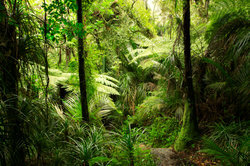Is tropical precipitation more productive than extra-tropical?
The tropical climate zone is understood to mean the area that is bounded by the two tropics of the earth. This is the area of the earth that lies on both sides of the equator and has fairly constant temperatures from month to month. But what about precipitation? Are these also constant and above all - are tropical rains more productive than extra-tropical ones?

Rainfall in the tropics
In fact, the average rainfall in many areas of the tropics is higher than that of most non-tropical areas. Are you wondering why that is? Basically, the best way to explain the nature of tropical rain is through the tropical sun.
- Many parts of the tropics are in the immediate vicinity of the equator. Here the sun is above average. You are certainly aware that this means that there is now particularly strong solar radiation, which in turn allows a lot of water to evaporate.
- The excess amounts of evaporated water thus become humidity. If you have already been to the tropics, you will surely have noticed that Europeans find it difficult to breathe even there because of the high humidity.
- The air, which is extremely humid as a result of evaporation, warms up under the still strong sunlight now continue to be constant until the air masses are so warm that they finally rise, cool down and rain down.
- The system described does not apply equally to every tropical area, but only to the tropical equator. In Colombia, the resulting rainfall is particularly high with an average of 10,000 millimeters per year.
- That not the climatic zone of the tropics, but much more the proximity of the equator of many tropical areas for more abundant rainfall The decisive factor goes back to the phenomenon of the trade winds there, the rain-rained air from the tropics back to the equator drive back.
- The now actually dry air masses are driven by the winds across the ocean, where they recharge with moisture and finally arrived at the tropical equator again rain down. The proximity to the ocean, together with the winds, is one of the most important factors for the high levels of tropical precipitation.
Alternating humid tropics - explanation
Alternating humidity, or summer humid tropics, are characterized by a strong ...
Where the tropical rain is hardly more productive than the extra-tropical
- As noted above, the amount of precipitation in the tropics depends primarily on the proximity of the equator and its trade winds. In the southeast Asian tropics, for example, there is now no trade wind, here the monsoon wind system prevails. This means that torrential rain occurs during the summer half of the year, with the extreme dry season prevailing during the winter half of the year.
- The further you get away from the equator, the less precipitation you will be able to record. The tropics as a climatic zone mean an incomparably wide space, whereby the classification of an area in the tropical climate zone does not say much more than that there are no thermal seasons in the corresponding area to rule.
- If you now look at the entire tropical area, you will see that a distinction must be made between 5 different vegetation zones. The area with the highest rainfall is the tropical rainforest, which forms between 9.5 and 12 humid months.
- In the wet savannah, the humid months are already between 7 and 9, whereas the dry savannah only has 4.5 to 7 humid months. The thorn-bush savannah and the desert ultimately form those intra-tropical vegetation zones, their average The amount of precipitation per year is not more productive, but rather less productive than that of many extra-tropical ones Areas.
How helpful do you find this article?


